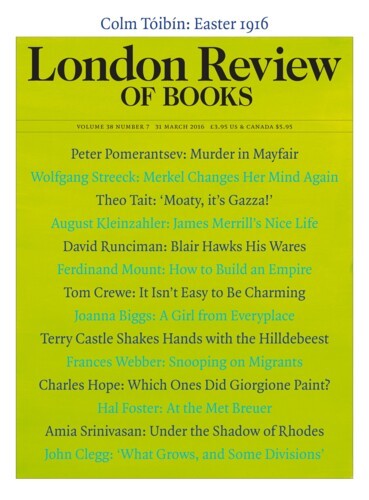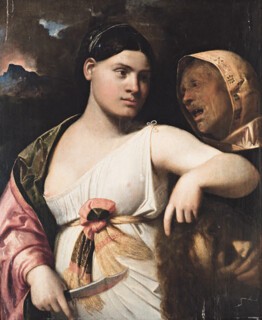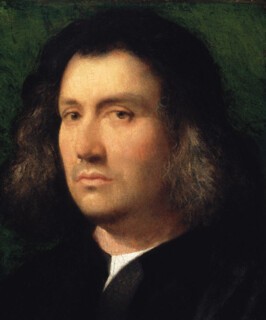Giorgione (c.1477-1510) is unique among famous European painters in that at different periods he has been credited with entirely different pictures. Even today, there is great disagreement about what he actually painted. Of the 47 exhibits listed in the catalogue of the show at the Royal Academy (not all of which were on display at the press view), 14 were described as ‘attributed to’ so and so, meaning that their authorship is still controversial. (The show closes on 5 June.) My own view is that this is an understatement, and that the attribution of more than half of the paintings is open to question.
Although Giorgione had already been mentioned a couple of times in print, the basis of his fame was the biography included in Vasari’s Lives of the Artists, first published in 1550. This was based on notes of paintings that Vasari had seen during a visit to Venice about eight years earlier, at a time when he seems to have had no intention of writing a book and no reason actively to seek out information about artists. Most of the attributions were clearly wrong, because in the second edition, published in 1568, the majority of works previously given to Giorgione were credited to other artists, and were replaced by various portraits, some of which he certainly never painted.
Vasari’s book established the idea that Giorgione was an outstanding artist, a sort of Venetian counterpart to Leonardo, but Vasari was vague about what was distinctive about his work, beyond indicating that all Venetian painters worked in the idiom of Giovanni Bellini until about 1506, when Giorgione introduced a different and apparently more atmospheric way of painting, in which preliminary drawings played no part. Because he was very famous and because there were no oil paintings on public display, in Venice or elsewhere, that could be unambiguously identified as by Giorgione, over the following centuries more than two hundred pictures were attributed to him, most of which had almost nothing in common; and it is now recognised, for example, that all of those credited to him in the two main books about Italian art published around 1800 were painted years or even decades after his death.
In the course of the 19th century, as more was discovered about other painters working in Venice, many pictures were gradually eliminated from Giorgione’s oeuvre, and he was left with the ones which did not seem readily identifiable as the work of some other named artist. Because these were not at all consistent in style, it was and is widely assumed that his style changed very drastically in the course of his short life. However, in 1800 some evidence came to light that made it possible to identify a few of his pictures. This consisted of a set of notes of the contents of several Venetian private collections compiled in the 1520s by a man named Marcantonio Michiel, who seemed to be unusually interested in recent art, and who included references to about a dozen pictures by Giorgione. None of these pictures was identified until 1847, when it was pointed out that The Three Philosophers in Vienna, which had long been thought to be by Giorgione, must be one of the works described by Michiel. Unexpectedly, Michiel said that it had been begun by Giorgione, but finished by Sebastiano del Piombo. Modern writers on Giorgione almost always say that the painting looks like the work of only one artist, and that although the heads of two of the figures are very similar to those in paintings that are certainly by Sebastiano, The Three Philosophers must be almost entirely by Giorgione. It would be more consistent with the evidence to suppose that the picture was designed by Giorgione and largely painted by Sebastiano, perhaps after Giorgione’s death; but this possibility has never been seriously discussed.
In 1871 a second Giorgione painting listed by Michiel was identified, the so-called Tempesta in Venice. This had always been regarded as a Giorgione, but it was one of eight pictures then in the same collection which were attributed to him, and it had not been much admired. Now it became the only extant painting for which there was unambiguous near contemporary evidence of his authorship.
The third painting identified as one of those by Giorgione described by Michiel was a Venus in Dresden, which the famous connoisseur Giovanni Morelli claimed in 1880 was a picture once in the Marcello collection in Venice. According to Michiel the landscape and a figure of Cupid (eliminated by a restorer in 1843) were by Titian. The same picture had been described in 1648 by the Venetian writer Carlo Ridolfi, who added that Cupid was shown holding a bird. Morelli’s identification, his apparent ability to recognise a masterpiece by Giorgione in a picture then considered to be a copy of a Titian, was long considered one of the great achievements of connoisseurship, but it cannot be correct. A report of a detailed technical examination of the painting published in 1992 revealed that although traces of the Cupid survived, he can never have held a bird. This should have been obvious all along: the picture has been in Dresden since 1699, and had the bird been visible while the Cupid was intact, someone in the 18th century would surely have identified the Venus as the one by Giorgione described by Ridolfi.
Over the past century two more pictures have been added to the list of undisputed works, on the basis of old inscriptions found on the back of the panels. One is Laura from the Kunsthistorisches Museum in Vienna, which, according to the inscription, was painted by Giorgione in 1506; the other is a Portrait of a Man in San Diego, dating from 1506 or 1508 (the date has partly disappeared). Taken together with the Tempesta these form a relatively homogeneous group, and it is not difficult to believe that The Three Philosophers was designed by the same artist. They also fit with Vasari’s claim that from about 1506 Giorgione worked in a style different from that of Bellini. But none of them looks much like any of the other paintings now widely accepted as by Giorgione; and it is telling that virtually all the famous experts who wrote about Giorgione’s work before 1930 failed to identify Laura for what it is, just as they accepted the Venus in Dresden. Yet their views on Giorgione continue to be cited as having some authority.
The San Diego portrait is the star of the current exhibition. It is flanked by two portraits by Dürer of about the same date, both painted in Venice in 1506; and the comparison shows how effective Giorgione’s innovations were in giving the figure a living presence and in representing the subtle effects of falling light. In the same room is a group of portraits of mostly dreamy young men, which in the past or even today have been thought to be by Giorgione. Some of them are rather beautiful, but none looks at all like the San Diego picture, which is more atmospheric, more subtle and more lifelike, but altogether less sentimental. As a group these pictures illustrate very well an attitude to the Italian Renaissance prevalent in the 19th century. But they don’t look like the work of one artist, and there’s no particular reason they should all have been painted in Giorgione’s lifetime. None of the other six pictures in the exhibition accepted as by Giorgione looks like his secure works, and the only significant reason for attributing them to him is that no one can agree on an alternative candidate. As almost all the experts are convinced, on the basis of no evidence at all, that, apart from Titian and Sebastiano (who soon left for Rome), there were no other painters of real talent working in this general idiom in North Italy in the years around 1510, it is not surprising that Giorgione and the young Titian are now each commonly credited with unrealistically vast numbers of paintings in a remarkable variety of styles.
In the case of Titian this is well illustrated by a couple of large pictures on the two end walls of the third room. One, Jacopo Presented to St Peter, is said to be c.1508-11, the other, Christ and the Woman Taken in Adultery, c.1511, yet in style and technique they look utterly different. The attribution of the second of them is justified by a comparison with some frescoes in Padua that Titian painted in 1511, with which it does have something in common – but many artists could have seen those frescoes. In the previous room there is a painting from the Uffizi said to be by Giorgione, The Trial of Moses, which was first attributed to him in 1795, when nothing was known of his style, and which resembles none of his secure pictures. However, the figures are very similar, and in one case virtually identical, to those in another set of frescoes in Padua dating from after Giorgione’s death. One would have thought that, by the logic used for the Titian attribution, the Uffizi picture ought to be by the painter of the frescoes it resembles. But this possibility is seldom even discussed.
Although the term connoisseurship normally carries associations with discernment and a certain rigour in aesthetic judgment, when applied to the study of Giorgione these qualities have been and remain conspicuously lacking. Optimistic guesswork would better describe the process. One of the exhibits at the Royal Academy, a picture called David between Saul and Jonathan, illustrates this very well. It was first attributed to Giorgione by the most influential Italian art historian of the last century, Roberto Longhi. In 1992 a letter about the picture Longhi wrote to the owner in 1944 was published in an exhibition catalogue. This was unexpected, because it had long been accepted that when art historians provided certificates for owners, a very common practice especially in the first half of the last century, these were simply written for money; and for that reason other art historians didn’t take them seriously and by convention didn’t refer to them in print. Longhi’s letter is long, vacuous and patently insincere; and in it he provides no real argument in favour of his stated opinion that the picture was by Giorgione, comparing it only to a supposed work by Titian then owned by a dealer with whom he was associated, which no one has ever taken seriously. But he held out the prospect of justifying his view in more detail. As he put it,
to explain in all due detail the reasons for a statement so weighted with critical responsibility is not the job of a simple letter. I hope to be able to do this in due course, in a proper essay, where my earlier opinions on the Master, often exploited (sometimes without quoting the source) by more recent scholars, will be given a more strictly personal justification.
But all he did was to include a very brief reference to the picture as a work of Giorgione in a book published in 1946, in a note and without an illustration.
Longhi was aware that the picture was almost certainly identical with one that had been recorded as a Giorgione in 1666, but it is impossible to believe that he took the attribution seriously. Several other art historians have done so, however, invoking his name in support of their opinions. The exhibition, in fact, gives a good overview of now widely held ideas about Giorgione: that he was a vastly influential and prolific artist, but had no coherent style of his own; that the pictures identified as his through Michiel’s notes and the inscriptions are not representative of his output; and that the attributions prevailing before those discoveries need to be taken seriously. A case in point is an extremely damaged Nymph and Satyr by the Ferrarese painter Dosso Dossi, hanging next to David between Saul and Jonathan. This was first attributed to Giorgione in the late 17th century, rejected in 1871 but then unexpectedly accepted by Morelli. Dossi had a very distinctive style, and the attribution is now universally accepted; but whether the picture had anything to do with Giorgione, as is often maintained, is far from clear.
The artist most fully represented in the show is Giovanni Cariani, from Bergamo, with six pictures. In evident contrast to the figure of Giorgione as described by the organisers, Cariani had a relatively consistent and recognisable style. His sensibility also seems very different from the sensibility now credited to Giorgione. Thus in his painting of Judith with the Head of Holofernes we see not only the decapitated head but also, right in the foreground, a knife still strongly marked with blood; and in the adjacent picture by him St Agatha touches one of her breasts, removed during her martyrdom, as they lie on a plate beside her.
In these examples the notion of artistic influence seems to be spread very thin. But there is a more interesting example in the exhibition, this time involving a picture in the third room, a Virgin and Child with an Angel. This is a signed and dated work by Domenico Mancini, and the inscription on the picture is the only known evidence of his existence, but the picture itself is impressive. In their general arrangement the Virgin and Child were taken from a well-known altarpiece by Giovanni Bellini, but two sections of the Virgin’s drapery, the sleeve of her right arm and the lower section of her robe, are identical, fold for fold, with the corresponding passages in a small picture, The Virgin with St Anthony and St Roch from the Prado, which hangs beside it, with an attribution to Titian. I am not aware of any other case in the history of Western painting in which an artist is supposed to have borrowed, for no obvious reason, two such insignificant details from the work of another painter. It seems more logical to suppose that Mancini repeated himself, and that both pictures are by him. But to concede that would be to admit that the painters of Venice and its territories whose reputations have survived were not the only ones of ability active there in the early 16th century. Art historians have been much happier to accept the idea that if the Prado picture is not by Giorgione, as Morelli believed, it must be by Titian, as if these two painters were at a certain point almost interchangeable – a sort of Picasso-Braque situation. But that may just be wishful thinking, in the same way as the idea that almost all the changes in Venetian painting in the decade around 1510 were somehow due to Giorgione. It would be wiser to admit that, in our current state of ignorance, it is impossible to say how much influence he had on his contemporaries and successors, and what that influence might have involved.
Send Letters To:
The Editor
London Review of Books,
28 Little Russell Street
London, WC1A 2HN
letters@lrb.co.uk
Please include name, address, and a telephone number.



